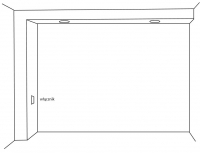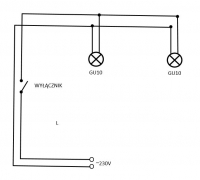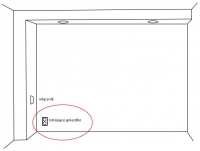Hi,
I have not found a similar thread so I will describe the situation.
I want to make a plasterboard shelf in one of the rooms and install lighting in it (I have not decided yet whether LED or halogen lamps) in GU10 luminaires, which will nicely illuminate the stone wall. And here the question arose - how to power these halogen lights / LEDs. Normally, I would have to put a new power cord in the ceiling and change the switch to a double one, but I do not have the money and time to renovate the entire room. That's why I came up with the idea - and that's why I'm asking you - to power these bulbs from a 230V socket. I will not plug directly into the socket, but I would like to connect to the socket with a cable.
The wall should look like this:

.. and a (sketchy) diagram of the connection of the whole

Generally, I would like to make a cable with two plugs on both sides: one would connect to the extension cord / electrical socket, and the other side to this installation (i.e. the socket that I will lead out on the built-in plasterboard.
I understand if you comment badly about the idea, but unfortunately connecting to the lighting installation in the room forces me to renovate the entire room (forging in the walls and ceiling for new cables), and I do not have money and time for that.
I will be grateful for your support and other, maybe better, ideas.
[EDIT]
I think I exaggerated with this two-plug cable Change of concept - as there is one socket on this wall, I have a plan to carve some wall and connect to the socket in the LL and LV box, without the PE wire. It will be safer.
Change of concept - as there is one socket on this wall, I have a plan to carve some wall and connect to the socket in the LL and LV box, without the PE wire. It will be safer.
I have not found a similar thread so I will describe the situation.
I want to make a plasterboard shelf in one of the rooms and install lighting in it (I have not decided yet whether LED or halogen lamps) in GU10 luminaires, which will nicely illuminate the stone wall. And here the question arose - how to power these halogen lights / LEDs. Normally, I would have to put a new power cord in the ceiling and change the switch to a double one, but I do not have the money and time to renovate the entire room. That's why I came up with the idea - and that's why I'm asking you - to power these bulbs from a 230V socket. I will not plug directly into the socket, but I would like to connect to the socket with a cable.
The wall should look like this:

.. and a (sketchy) diagram of the connection of the whole

I understand if you comment badly about the idea, but unfortunately connecting to the lighting installation in the room forces me to renovate the entire room (forging in the walls and ceiling for new cables), and I do not have money and time for that.
I will be grateful for your support and other, maybe better, ideas.
[EDIT]
I think I exaggerated with this two-plug cable



